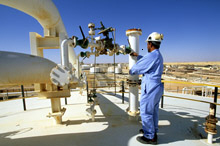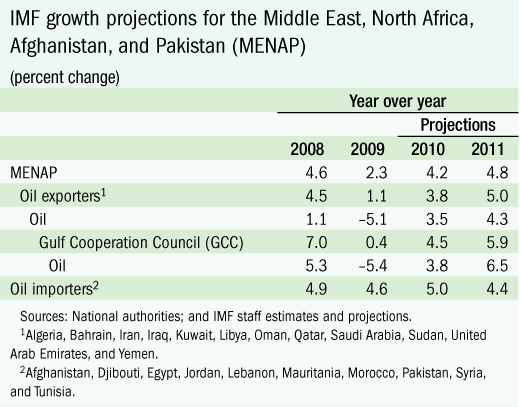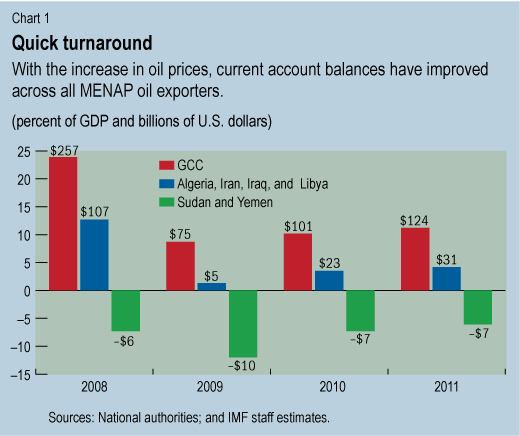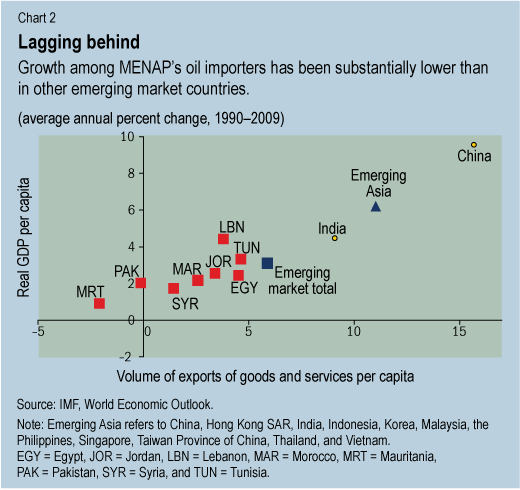
Typical street scene in Santa Ana, El Salvador. (Photo: iStock)
IMF Survey: Growth Rebounds in Middle East, North Africa
October 24, 2010
- Upturn in worldwide demand, oil prices spurs regional recovery
- Addressing financial sector vulnerabilities remains a priority
- Job growth, competitiveness are key to region’s development
The Middle East and North Africa (MENAP) region is experiencing a robust recovery, aided by rising oil prices and higher oil production levels, a new IMF report says.

Oil field in Marmul, Oman: because of the rebound in global demand, the region’s oil exporters are seeing stronger growth (photo: KPA/Hackenberg/Newscom)
REGIONAL ECONOMIC OUTLOOK
The IMF’s Regional Economic Outlook for the Middle East and Central Asia, released October 24, says the MENAP region’s output is projected to expand by some 4.2 percent in 2010, up from 2.3 percent in 2009 (see table).
“We expect most countries in the region to grow faster in 2010 and 2011 than in 2009,” IMF Middle East and Central Asia Director Masood Ahmed told a press conference in Dubai. “With the economic recovery taking hold, the region needs to resume its focus on medium-term challenges: diversification and financial market development for the oil exporters, and tackling unemployment through faster, job-creating growth in the emerging markets.”

Oil exporters see visible improvement
For the MENAP oil exporters—Algeria, Bahrain, Iran, Iraq, Kuwait, Libya, Oman, Qatar, Saudi Arabia, Sudan, the United Arab Emirates, and Yemen—economic activity is picking up considerably. With the rebound in worldwide demand, crude oil production is projected to grow to 25 million barrels per day (bpd) in 2010 and 26 million bpd in 2011. As a result, oil GDP will register growth rates of 3.5 percent in 2010 and 4.3 percent in 2011.
The rise in oil prices—by 23 percent in 2010 and more than 3 percent in 2011—is also leading to a marked turnaround in external balances. The combined current account surplus of these countries is projected to rise by about $80 billion on current oil price expectations; of this, close to $50 billion is accounted for by the countries of the Gulf Cooperation Council (GCC) (see Chart 1).

Non-oil activity is also projected to pick up, but more gradually by only 1 percentage point between 2009 and 2011, the IMF report said. In most countries, non-oil-sector growth continues to rely on supportive fiscal policy with private financing and credit still sluggish. Unlike some other regions, capital inflows have so far shown only a small resurgence in the MENAP oil exporters.
With the recovery in oil prices and non-oil activity, fiscal balances are expected to improve across the MENAP oil exporters. For the GCC countries, the improvement is almost 7 percentage points of GDP between 2009 and 2011.
Where fiscal space is available and signs of either self-sustaining private-sector activity or overheating are absent, fiscal policy should remain expansionary through 2011, the report noted. One group of countries—several GCC countries and Algeria—has had ample fiscal space, thanks to low debt levels and large buffers built up prior to the crisis, giving them the opportunity to implement stimulus in 2009–11. Iran, Sudan, and Yemen, on the other hand, have little fiscal space and are narrowing their deficits over this same period.
Among many oil-exporting countries, as with most MENAP oil importers, inflation is currently low, though in some countries there are some signs of emerging inflationary pressures. The monetary policy challenge is to balance the need to support a revival of credit growth while counteracting a potential resurgence of inflation.
The IMF report also said that policymakers in the MENAP oil-exporting countries should concentrate on the following structural challenges:
• Promoting economic diversification. Given the region’s recovery, oil exporters are able to strengthen their focus on the medium-term objective of promoting economic diversification and reducing the dependence of both the budget and the economy on hydrocarbons.
• Building on financial sector development. For the GCC, the challenge is to consolidate the gains made in the past, address any remaining vulnerabilities uncovered by the crisis, and pursue regulatory and supervisory reform in line with evolving international norms. For some other oil exporters in the region, the challenge is to spur greater financial development by removing entry and exit barriers and reducing state ownership in the banking system.
Oil importers need job-generating growth
The region’s oil importers—Afghanistan, Djibouti, Egypt, Jordan, Lebanon, Mauritania, Morocco, Pakistan, Syria, and Tunisia—have moderately strengthened in 2010, with the exception of Pakistan, which was hit by devastating floods in mid-2010. Oil importers as a whole are projected to grow 5 percent in 2010, up from 4.6 percent in 2009.
In light of stronger growth, the region’s governments are resuming efforts to strengthen public finances, the report noted. While public debt levels in most MENAP oil-importing countries are higher than the emerging-market average, improvements in fiscal positions in run-up to the global crisis gave room for stimulus that limited the fallout in 2008–09. With the resumption of fiscal consolidation, government deficits are projected to narrow in 2011 in most countries.
The report recommended that policymakers in MENAP’s oil importers focus on the following priorities:
• Raising growth to generate employment. During the past two decades, per capita growth among the oil importers has been substantially lower than in other emerging markets, mirroring a weak trade performance (see Chart 2). Faced with already high unemployment—an average of 11 percent in 2008—the challenge for the oil importers will be to raise growth to provide employment for a working age population that is growing faster than in almost all other regions. To absorb the currently unemployed and new labor market entrants over the next decade (and assuming that the ratio of jobs created to economic growth remains constant), annual growth would need to reach 6½ percent.
• Enhancing competitiveness. MENAP oil importers—many of which face burdensome regulatory systems, weak institutions, and a dominating public sector—have much to accomplish to become competitive relative to other more dynamic economies. Sound macroeconomic policies—in particular, fiscal consolidation—will help support competitiveness, but governments will also need to make greater efforts to improve the business climate.
• Fostering trade. The region’s trading patterns remain oriented mainly toward Europe, and there has been relatively little change in the product mix. Although there has been some diversification of trade links, the region has benefited relatively little from the expansion of Asian and Latin American powerhouses—which contribute close to half of global GDP growth, but account for only about 9 percent of the region’s total exports.








